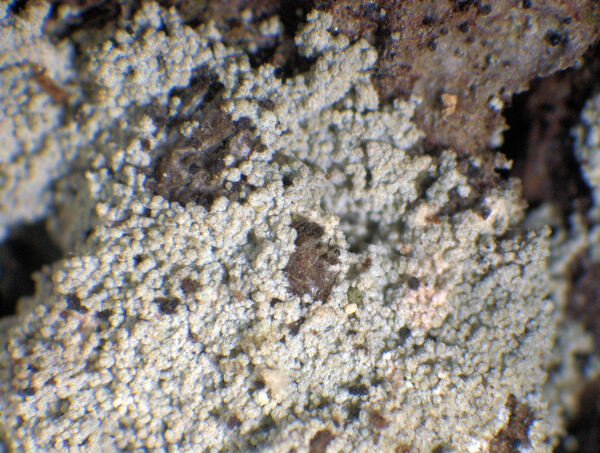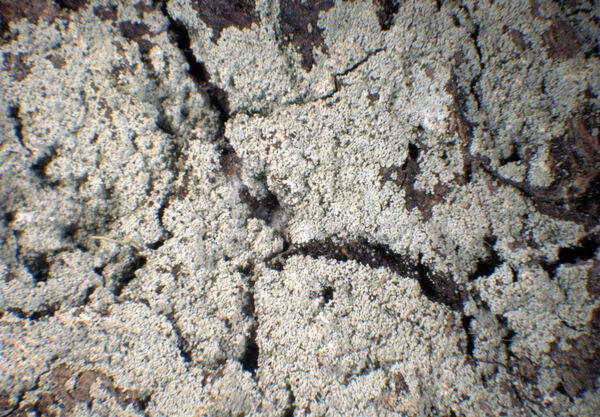Lepraria elobata Tønsberg
Sommerfeltia, 14: 197, 1992.
Synonyms:
Description: Thallus leprose, discontinuous and not stratified, initially composed of isolated granules that divide to form aggregations, eventually merging to form a <0.1 mm thick crust, pale to dirty blue-grey, usually poorly delimited. Medulla not evident. Granules (18-)25-45(-68) μm in diam., rather compact, usually without projecting hyphae, well separated from one another or sometimes gathered into up to 120 μm thick units. Photobiont chlorococcoid. Spot tests: K+ yellow sometimes turning brownish, C-, KC-, P+ yellow-orange, UV-. Chemistry: atranorin, stictic, constictic and cryptostictic acids, zeorin and very rarely an unidentified fatty acid (major to trace).
Growth form: Leprose
Photobiont: green algae other than Trentepohlia
Reproductive strategy: mainly asexual, by soredia, or soredia-like structures (e.g. blastidia)
In underhangs rarely wetted by rain
Commonnes-rarity: (info)
Alpine belt: absent
Subalpine belt: rare
Montane belt: rather common
Dry submediterranean belt: rather rare
Humid submediterranean belt: rare
Padanian area: absent
pH of the substrata:
1 2 3 4 5
Solar irradiation:
1 2 3 4 5
Aridity:
1 2 3 4 5
Eutrophication:
1 2 3 4 5
Poleotolerance:
0 1 2 3
Altitudinal distribution:
1 2 3 4 5 6
Rarity
absent
extremely rare
very rare
rare
rather rare
rather common
common
very common
extremely common
Loading data...
Occurrence data
Predictive map
Growth form: Leprose
Photobiont: green algae other than Trentepohlia
Reproductive strategy: mainly asexual, by soredia, or soredia-like structures (e.g. blastidia)
In underhangs rarely wetted by rain
Commonnes-rarity: (info)
Alpine belt: absent
Subalpine belt: rare
Montane belt: rather common
Dry submediterranean belt: rather rare
Humid submediterranean belt: rare
Padanian area: absent
pH of the substrata:
| 1 | 2 | 3 | 4 | 5 |
Solar irradiation:
| 1 | 2 | 3 | 4 | 5 |
Aridity:
| 1 | 2 | 3 | 4 | 5 |
Eutrophication:
| 1 | 2 | 3 | 4 | 5 |
Poleotolerance:
| 0 | 1 | 2 | 3 |
Altitudinal distribution:
| 1 | 2 | 3 | 4 | 5 | 6 |
Rarity
absent
extremely rare
very rare
rare
rather rare
rather common
common
very common
extremely common
Loading data...
Occurrence data
Predictive map








